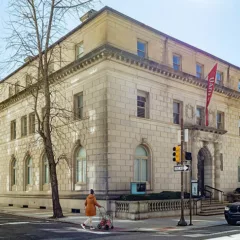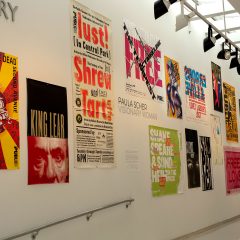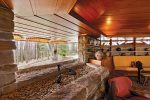Fallingwater is on Wendy’s bucket list. She said this as we piled into my Prius, Murray at the wheel, map maven David on shotgun, Wendy and me in the back.
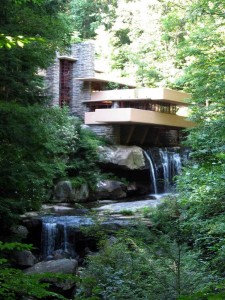
I don’t have a bucket list. But I do have a list of things I want to do, and this has been on my list since 1968, the year when my friend Lenore Malen also told me about the Barnes, Rauschenberg and poached salmon.
I take advice. So I visited the Barnes post haste and bought a fish poacher. And Rauschenberg is in all the museums. But Frank Lloyd Wright’s Fallingwater has been on my back burner ever since, even though I’ve driven right past the signs on the Pennsylvania Turnpike numerous times.
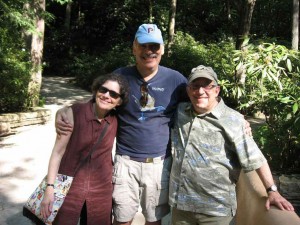
Wendy, who also wanted to visit a concrete motel shaped like a shoe (more about that later), sprung the group into action. We made reservations for a tour (the only way to get inside) and for a B&B that we hoped was suitably frou-frou-B&Bish (more on that later, too).
We quickly established road rules–no turnpike food and absolutely no turnpike food, and perhaps a thumbs up if we happened upon some peach pie. That was how we came upon the waitress who didn’t like us (What!!!!???). We know this because when we asked for some jam, she threw a handful of portion-control little jam tubs on our table. One could argue that she merely tossed them; either way it was rude. We did consider alternate explanations, like maybe her feet hurt.
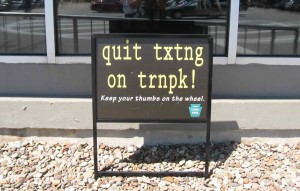
The unfortunate jelly-tub incident was outside of Bedford. After lunch, we saw that downtown Bedford had a number of cute cafes and eateries. Damn. David, who likes to laugh, tried to get out of the car when he saw the HeBrews Coffee Company, but Murray kept his foot on the gas peddle.
When we came to Fallingwater, I had promotional photographic images in my mind–with bright lights and shiny windows. But Fallingwater was built to be a part of the landscape. The neutral concrete and rock surfaces are, while not invisible, not exactly splashy. My first reaction was disappointment. My second reaction was, Wow, this is really great. It does almost melt into the trees and hills.
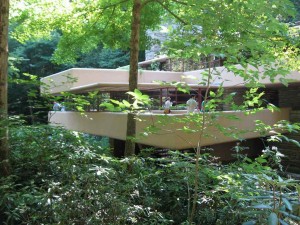
As advised, we made our tour reservations in advance, and were stunned to learn we were the 68th tour of the day. The gift shop was jammed as was a waiting area, and we learned the place gets about 150,000 visitors a year, and it’s not even open year round. Plus it’s out of the way–a ride up into the mountains from nowheresville on the Pennsylvania Turnpike.
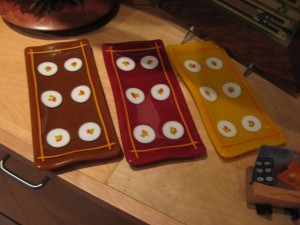
Many of you probably know the next two paragraphs, so just skip if you do:
The building was commissioned in 1935 but looks fresh and contemporary with just a whiff of what we now think of as 1950s style. Frank Lloyd Wright, who was 60 when he finished it, built the place for the owners of Kaufmann’s Department Store (later subsumed by Macy’s). Their son Edgar Jr., a student of Wright’s, talked his parents into hiring the architect.
The Kaufmanns thought they were going to get a building with a view of the Bear Creek waterfall. Instead, Wright placed the building cantilevered right over the falls.
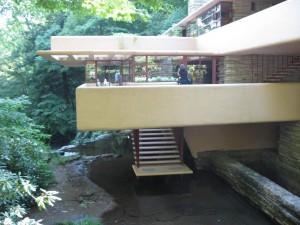
The building made Wright a household name when Time Magazine in 1938 featured him and Fallingwater on its cover. After that, Wright achieved more than half his life’s work, said our tour guide, Liz. He was a late bloomer. And he was no doubt happy to get the commission, which came when the Depression must have been killing architects.
So let’s get the truth about the famous cantilevered building out of the way right now. The flying wings of reinforced concrete and steel that float above the falls sank 7 inches shortly after the building was finished, an error in the materials. Ten points for concept. Two for execution.The cantilevered platforms were reinforced and stabilized in 2002 by the Pennsylvania Conservancy, which was entrusted the building in 1963 by Edgar Jr.
The interior of the house is austere, with Wright, a control freak, designing all the cabinets and closets and even the furniture. (Mrs. Kaufmann rebelled against his choice of dining room chairs; Wright was not happy with her choice, either).
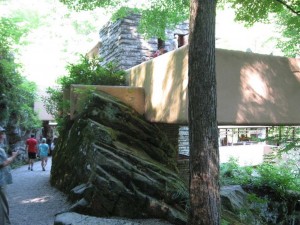
Wright’s hallways are like caves, chilly, dank, and narrow with low ceilings and with walls of concrete and stone. Our tour guide told us Wright did this on purpose, to prevent switching the furniture. Devious and diabolical! (I have no pictures of the interior, which are not permitted).
Wright’s attention to detail was astonishing. He designed the lighting so it was indirect and ahead of its time. He lined the bathroom with cork (now quite trendy) and selected a gorgeous shower head the size of a dinner-plate. He used caned shelves in the clothes closets, for air circulation. The closets look beautiful, with their North Carolina walnut veneers. The veneers cover marine grade plywood! The windows unfold around the corners of the structure to catch the breezes; they have minimum framing so as not to impede the effect of being in the landscape. And the effect of being atop the falls is soothing and cooling.
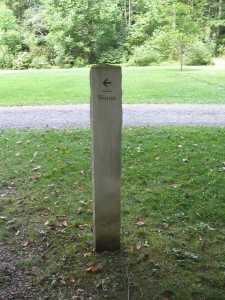
For all that, when it’s hot, it’s hot. But I’d rather be at Fallingwater than in Philadelphia when the mercury hits 100.
The visionary design was an exercise in egotism and bullying in other ways as well. The original agreed upon price was a small percentage of the final bill, which was a whopping $155,000 (Included $8,000 architect’s fees, and $4,500 for installed walnut furnishings). I got this off of the website, which has lots of detailed info, but our guide also mentioned it as well as the original price, which I failed to jot down. Somehow, Wright convinced the Kaufmanns to keep on paying as the project grew in detail and scope.
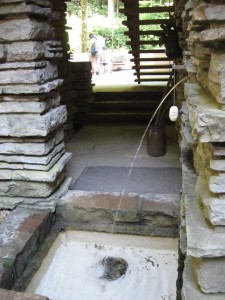
The son, Edgar Jr., who died a bachelor and never seemed to settle down professionally either although he did teach, was the moving force behind all this. He adored Wright, who was his teacher. And whatever Wright proposed (imposed?), Junior got his parents to agree to.
After the visit, I found myself wondering about what it takes to do something truly extraordinary. I suppose arrogance and self-assurance need to be part of the parcel to prevail over the forces of moderation and ordinariness.
Among the charms of the visit is seeing a guest bedroom with a little Diego Rivera on the wall. Here was a Tiffany lamp, there some Japanese woodblock prints, and on the patio BKF chairs from Argentina (the original wire butterfly chair).
The building is still how people like their homes to look, horizontal with lean modernism inside and out. Only the furnishings seemed to date it. The date they suggest, 1940s and ’50s, is way later than the actual date of the 1930s designs.
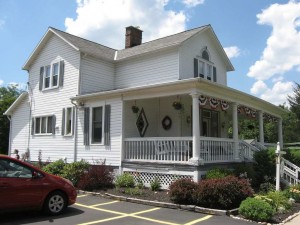
We spent the night in a nearby B&B, the Country Seasons Bread & Breakfast Inn, owned by a young, hard-working couple who said they had customers from the day they opened their doors. Our hostess, named Liberty, called herself Libby, so we knew we were in good hands. (Our room’s seasonal theme was Fall Harvest, and Wendy and David had Summer Garden). The rooms were ship-shape and spic-and-span, with every corner put to good use–nothing lavish but comfortable and thoughtful.
The other Libby ran the place with some martial control, but it paid off: When we came to breakfast at the appointed hour, everything came piping hot out of the oven, cooked to a turn.
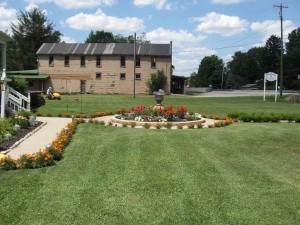
In light of Frank Lloyd Wright’s use of concrete, on the way back Wendy proposed we all take a trip to the all-concrete motel shaped like a shoe that I mentioned at the top of the post. The proposal was met with some reluctance on the male side. But I was enthusiastic. A week or so later, Wendy reported we were too late–it had gone out of business who knows when. I suspect concrete is not a friendly material in mid-winter in Pennsylvania. The all-concrete Fonthill Castle in Doylestown also is too cool and dank for winter. And it too was built by an obsessive person, convinced of his own ideas. (Wright’s building uses local stone and concrete, but his was a summer house, so it made good sense).
Our food adventures were not yet over. Again we got off the turnpike, this time in Lancaster County. Did we find a nice diner? Noooo. Did we find a sweet cafe? Not a chance. We found a salad-bar kind of place, part of a chain, packed with locals. I’m certainly not sure why we thought it might be good.


